Bodhipaksa's Blog, page 71
August 19, 2012
From the mouths of babes, 2008–2012
 My wife has been collecting some of the funny things that our two kids, Maia (now 5) and Malkias (just turned 4) have said. I’ve added a couple of my own, but unless stated otherwise they’re from my wife and the comments are hers.
My wife has been collecting some of the funny things that our two kids, Maia (now 5) and Malkias (just turned 4) have said. I’ve added a couple of my own, but unless stated otherwise they’re from my wife and the comments are hers.
I challenge you to read this to the end without cracking up with laughter.
While looking out the window: “The croissant moon!” Maia, 2
“Sometimes Twitter and Facebook eat us. Indeed.” Maia 2 ½
[Added by me] Maia, why did you pinch my nose? “I don’t know, daddy. I did it automatically.” Maia, 2 ½
“Daddy, I’m in danger.” “In danger of what?” “I’m in danger of spilling my yogurt.” Maia, 3
“Mommy, I need my own computer.” Maia, 3
Spoken into a compact mirror that opens like a cell phone: “Hello Barbara, I hope you have a very happy birthday. Your party sounds delightful, but my mom can’t come.” (Don’t worry Barbara, I’ll be there, but Maia’s not too thrilled about me leaving for the evening.) Maia, 3
Me: “Maia, let’s write a letter to Aunt M.” Maia: “OK, B, F, I, E. Those letters.” Maia, 3
“You can’t judge a book by its cover. You just can’t. No one can.” Maia, 3
From the mouths of vegetarian babes, while pointing to the deli counter: “Are those dead things? Is that woman going to eat dead things?” Maia, 3
“My pretend baby dinosaur bit me. But it’s not real, so it’s not bleeding.” Maia, 3
To her yoga teacher: “I have a book about dead people.” Maia, 3
“My listening ears are off.” I had kinda suspected as much., Maia 3 ½
“I want to answer the phone! Hello?…. Hello? Oh, OK.” Hangs up. “It was a wrong number.” Let’s hope so. Maia, 3 ½
Maia, upon seeing a Girl Scout flier: “Can I join the boy scouts instead?” Maia 3 ½
“Bye, Mommy,” as he grabbed my car keys off the table and headed towards the front door., Malkias, 1 ½
“You don’t get out that much, Mom.” Yeah, I wonder why that is? Maia 3 ½
From the mouths of vegetarian babes: “Can we pretend we’re meat hunters?”
Sure, what kind of meat would you like to pretend to hunt?” “Vanilla.” Maia 3 ½
“Excuse me, can I be alone now?” as she slides the bathroom door closed. Maia 3 ½
Maia: “Sorry to burst your bubble, mom.” Me: “You burst my bubble?” Maia: “Yeah, a long time ago.” Maia 3 ½
“Mommy, can you help me throw up?” It’s not all cuteness and hearts around here. Maia 3 ½
From the mouths of adopted babes: Maia, to a new mother: “Where did your baby come from?” New mother: “I gave birth to her.” Maia: “Oh. How old was she when you gave birth to her?” Maia, 3 1/2
“Pretend you want more money, Mommy.” Pretend? Maia 3 ½
From the mouths of Buddhist babes, “Malkias, can you say Viriyalila – Vir-ee-a-lee-la?” (This is Maia trying to teach her brother how to pronounce our friends’ names.) Maia, 3 1/2
“Jack be nimble, Jack be quick, Jack jumped over the candlestick.” Thoughtful pause. “Well, that doesn’t sound very safe.” Maia, 4
“The sky bigger and bigger” (Translation: the sky is getting bigger and bigger). Metaphorical statement or astronomical observation? Who can know the mind of a two year old? Malkias, 2
I’m sorry, I can’t do that right now. I’m busy talking to my audience.” Maia, 4
[Added by me] Maia, watching her brother chug on a bottle of milk. “Milk is so passé!” Maia, 4
“Why, Mommy, why? Tell me, Mommy, tell me why.” Malkias enters the ‘why’ stage in his own inimitable style. Malkias, 2
Me: “Wait a second, Maia, I can only do one thing at a time.” Maia: “But you have two hands!” Maia, 4
“He’s trying to break my heart!” shouts Maia, as Malkias scribbles over the heart she just drew. Maia, 4
“Oh, no! iPhone!” as Dad skimmed a large, square-ish stone into the waves. Malkias, 2 ½
As we passed a certain aisle in the grocery store: “Soon I’m going to need all that womanish stuff…. Hey, why are you laughing? It’s not funny, don’t laugh.” Maia, 4 ½
Me: “Stop throwing things, you’re making a mess.” Malkais: “That my job, Mommy, that my job.” Malkias, 2 ½
“I wonder who will be your son and daughter in your next life? Maybe it could be us again. Maybe Malkias could be first next time. Just an idea.” Maia, 4 ½
“I just can’t stop thinking about chocolate!!!” Maia, 4 ½ (Maia verbalized this, but I think she was reading my mind.)
“Oh, Buddha holding her,” upon seeing a picture of Bodhilocana, a family friend who had just passed away, sitting in the lap of a Buddha rupa at Aryaloka. Malkias, 2 ½
Me: “Malkias, you’re going to be three next week!” Malkias: “No I am not!!!” I rest my case. Malkias, almost 3
“My pretend injury is making me fall over a lot.” Maia, 4 ½
“Mom, we made up a rhyme!” “MINE,” yells the toddler. “Fine,” snorts the preschooler. And that sums up the developmental stages in our house today. Maia, 4 ½ and Malkias, 3
“Mom, I’m bored. Can you do something about that?” Malkias, 3
“Look, it’s the first star of the night! I’m going to make a wish. I wish… with all my heart… to be a fireman.” Maia, 5
“I want DRY water, not WET water, DRY water!” Malkias, 3
“Why are you using my computer?” asks the three year old as I type on MY computer. Malkias, 3
“And now I’m going to disturb Mommy!” Sorry, Malkias, FB beat you to it. The joys of working from home. Malkias, 3
While on the phone with her grandfather: “Papa, how do you think Barack Obama is doing as president of the United States?” Short pause. “I think he’s doing fantastico.”
“Be quiet! I am trying to think!” demanded the three year old. Malkias, 3
“Isn’t that so cool! I have the same name as the president of the United States of America!” I’ve been telling her this for four years, I guess it finally sunk in. (Bereket = Barack) Maia, 5
“Is it my turn yet? Me getting cranky about this.” Malkias 3 ½
“I know my brother is feeling better because he’s driving me nuts.” Maia, 5
“Mom, I think you need a new computer. I know just what you can do with the old one.” Yes, I bet you have great plans for this computer, Maia. Maia, 5
Upon arriving home from preschool: “Mommy, Mommy, Mommy! This news will brighten up your whole face! I had my first ever visit to my new kindergarten class today!” Maia, 5
As I twirled the bottom of the very last – and 20th – box braid: “Can you put my hair in 2 puffs instead?” Maia, 5
“A little bit is better than a lot,” said the five year old, upon learning that the three year old poured ‘ a little bit’ of water into the toaster. Maia, 5
“I want to change my shirt. I want to wear my Cars shirt,” he announced at 3:30 AM, after awaking me from a sound slumber. Malkias, 3
“It’s my yoga that helps me,” said the 5-year old, as she executed a complicated climbing maneuver at the playground. Maia, 5 ½
“But Lightning McQueen did it,” he said, trying to exonerate himself. Malkias, 3 ½
On her very last day of preschool: “I STILL don’t know what I want to do when I grow up.” Maia, 5 ½
“I had to give up. I’m sorry, Mom,” said the five year old, several minutes after I asked her to help the three year old get ready to go swimming. The three-year old is still running wildly around the house, half dressed, almost inspiring me to give up, too. Maia, 5 ½
While watching Olympic gymnastics highlights: “WOW” … silence … “Ooh, I can’t do that move” …. silence… “Look, he’s doing it all over again really slowly!” Malkias, 3 ½
“I can’t believe I’m touching a loose tooth … and it’s in MY mouth!” Maia, 5 ½
Related posts:
Twitter Updates for 2008-09-15
Twitter Updates for 2008-10-28
Back from Awassa and Aleta Chuko
August 15, 2012
Doctor Jekyll and Mister Amygdala
 A friend just wrote to me with a troubling story. He’s had a few upheavals in his life recently, including a divorce, but then he made a dreadful ethical slip and got involved with a former patient of his. Of course that’s a huge ethical no-no in the caring professions, and it may have life-long consequences for his career.
A friend just wrote to me with a troubling story. He’s had a few upheavals in his life recently, including a divorce, but then he made a dreadful ethical slip and got involved with a former patient of his. Of course that’s a huge ethical no-no in the caring professions, and it may have life-long consequences for his career.
But in responding to my friend’s letter I was reminded of Robert Louis Stevenson’s story, Dr. Jekyll and Mr. Hyde. Most of you know this story from cheesy horror movies, but the book is actually an astute spiritual parable that sprang directly from Stevenson’s subconscious in the form of a nightmare. The story stands up psychologically to the point where you can translate the characters into the terms of modern neuropsychology as represented by the work of author Wildmind contributor Rick Hanson, Ph.D.
Dramatis Personae
Dr. Jekyll, who is the neocortex and mammalian brain, responsible for self-monitoring, planning, advanced cognition, empathy, and compassion.
Mr. Hyde, who is the “reptilian” part of the brain, concerned with fight, flight, and fulfilling appetites.
The Story
Henry Jekyll is a good doctor who helps many people through his work. He has a well-developed mammalian brain in which empathy and compassion are important. He is, however, deeply troubled by his amygdala-driven unexpressed bad-boy tendencies within. He is ashamed of them and afraid of them.
We all have “hindrances” — potentially destructive tendencies toward craving, hatred, and fear. Those tendencies manifest in our thoughts and our actions.
One thing all meditation teachers have to do is to let people know that it’s OK to have these hindrances. When people start self-monitoring (a neocortical activity), as they do when cultivating mindfulness, they start noticing distracted, craving, hateful thoughts. And their reaction is often to get upset about these. But that’s unhelpful, because that’s a case of responding to a hindrance with yet another hindrance. Yes, ultimately we want to get rid of the hindrances, but you can’t deal with them on their own terms, by getting angry about getting angry, or craving a lack of craving, or being afraid of being afraid, or getting despondent about noticing despondency.
These hindrances are not “bad.” They are actually mental behaviors that have evolved over millions of years in order to protect us. Someone threatens you, you get angry, they run away (hopefully). A big carnivore jumps out in front of you, you get scared, you run away. You see something you want, you grab it. And so forth. But these tendencies, while they work well in wolf-packs and worked well when we lived in caves, are maladapted for life in the modern world. Being angry with your computer when it’s working too slowly doesn’t change the computer, and just makes you unhappy and even ill. Bingeing on food because you want it can make us ill in different ways. Negative emotions undermine our relationships with others, so there’s a social cost. And even when they don’t have social or health drawbacks, our hindrances make us unhappy. Our sense of well-being is sub-optimal when we’re frustrated, or craving, or anxious.
The hindrances are not bad, they’re just strategies for finding security and wellbeing that happen not to work very well.
Dr. Jekyll is the man who sees these potentially destructive activities going on, but who is afraid of them. He’s the neocortex observing the amygdala. He identifies with his goodness, and psychologically disowns his hindrances. And he represses them. But in doing so, he’s acting out — internally — a form of violence driven by fear. The neocortex has been silently hijacked by the amygdala, since this fear actually stems from primitive, reptilian parts of the brain.
So Jekyll creates a drug that will anesthetize the bad boy within. He’s trying to anesthetize the amygdala, so that his neocortex no longer has to keep his “baser” instincts in check. But what he hasn’t realized is that over the years of repression, the bad boy has become much stronger. The repression Jekyll has done over the years is a form of inner violence, and thus has been feeding Hyde. And when Jekyll takes the potion it’s his good side (the neocortex, in modern terms) that goes offline, and the inner bad-boy (the reptile brain, the amygdala) that dominates. Mr. Edward Hyde is released. And it ain’t a pretty sight.
Once Hyde — a destructive monster who delights in violence and in indulging his unseemly appetites — is released, it’s impossible to keep him restrained. He becomes stronger with each outing. And indeed, when parts of the brain are exercised, the wiring in them becomes stronger. That part of the brain actually grows.
Of course the story doesn’t end well, and Jekyll is destroyed, but it’s a cautionary tale that we’re meant to learn from. So what should be learn?
What Jekyll should have done is to strengthen the neocortex by developing more mindfulness and compassion, so that the amygdala-driven Hyde would be known, contained without being repressed, and simply fade away through atrophy.
Easy to say! Let’s break that down a little.
When we stop reacting to the hindrances, and either simply accept them without acting on them, or cultivate their opposites — qualities of love, confidence, etc. — the neocortex actually grows. That part of the brain becomes thicker. The number of connections running back to the amygdala increases, so that the reassuring signals reaching it (“It’s OK. There’s no need to panic and get violent. I have this covered”) are stronger. And the amygdala actually shrinks. The brain is a real energy-hog, and takes a lot of work to maintain. If our fight-or-flight mechanisms are not needed, then the body somehow knows that it’s time to remove some of the brain circuitry necessary for those mechanisms.
So Dr. Jekyll is not conquered through fear and repression. He’s conquered through mindfulness and compassion.
It’s worth mentioning that this process of dealing skillfully with hindrances can be short-circuited by “spiritualizing” them. All those spiritual teachers who turn out to have been living double lives, giving inspiring teachings while sleeping with their students? Usually they’ve been telling themselves, and their partners, stories about how the relationships are “sacred” or an expression of non-duality. This is just another example of the amygdala hijacking the neocortex. The old way was, you want, you take. In a spiritual context you want. You make up a half-way convincing story. You take.
This reminds us that Mr. Hyde is sneaky. We need to give the neocortical Dr. Jekyll a lot of exercise, through practicing mindfulness and compassion. And we also need other people to give us feedback and to call us on our bullshit. We need sanghas. Getting enlightened is a team sport.
August 14, 2012
Five tips for National Relaxation Day
 In our fast-paced world it seems everyone’s stressed, hassled, and exhausted, so it’s a good thing that August 15, 2012 has been declared National Relaxation Day.
In our fast-paced world it seems everyone’s stressed, hassled, and exhausted, so it’s a good thing that August 15, 2012 has been declared National Relaxation Day.
When they think about relaxing, most people would tend to hit upon rather conventional things, like soaking in the bath, having a glass of wine at the end of the evening, or watching a movie. But those things are temporary fixes that don’t lead to long-term change. Instead, I’d like to suggest five habits that can be cultivated and practiced every day. These are skills that can become a permanent part of the way you function in your daily life, and bring you long term benefits. And you can do them whether or not you have time for a long relaxing soak in the tub.
1. Take your time eating
We all have to eat, and we don’t generally do it very mindfully. We watch TV while we eat, or we read, or we’re caught up in a conversation, or we just space out. Sometimes, heaven help us, we even eat while we drive.
It’s very enriching, and deeply relaxing, to eat mindfully. It might not be feasible to eat every mouthful of food with complete attention, but what if we were to eat the first and last mouthful of a meal or snack mindfully? Whether you’re eating a gourmet meal or a candy bar, really notice the movements of your body as you transfer the food toward your mouth. Notice yourself receiving the food — how it feels, tastes. Eat slowly. Chew methodically. Savor the experience. If you find you’ve plowed into your food and are mindlessly scarfing it down, pause, and take the next bite with full awareness.
2. Give yourself short breathing breaks during the day
You may have heard of the three-minute breathing space, in which you spend a minute just tuning in to an awareness of your experience, a minute focusing on the sensations of the breathing in order to gather your attention, and a minute expanding your awareness so that you’re no longer noticing just the breathing, but also other sensations from the body, your mind and emotions, the sounds, light, and space around you. Even on the busiest of days it’s a good idea to take a few of these three minute breaks.
If that seems impossible, then just pause what you’re doing, take a few mindful breaths, and then bring your attention back to the task at hand.
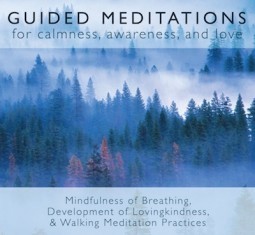
Check out Bodhipaksa's meditation CDs and MP3s
3. Notice what your thinking is doing to youA Harvard study of 250,000 people found that they spent almost 50% of their waking time thinking about something other than they were doing. What’s more, they found that the people who were most distracted were more likely to report feelings of unhappiness. Much of our thinking promotes unhappiness.
So develop the skill of checking in from time to time to see what your thoughts are doing to you. Notice whether you’re relaxed or tense, whether your overall experience is pleasant or unpleasant, whether you’re happy or distressed. Notice this without making any judgements about yourself. It doesn’t mean you’re “bad” or a “failure” for harboring thoughts that make you feel bad. But see if you can just notice those thoughts, and let them pass away. Actually, just to notice how you’re feeling you have to let go of some of the compulsion around these inner dramas.
4. Reduce input channels
One thing that really stresses us is being interrupted. So give yourself a chance to focus. If you’re writing a report, shut off your email program, turn your phone off (don’t just switch it to vibrate). Close any programs you don’t need to have open. It’s just you, and the task. You’ll find that when your concentration isn’t interrupted, you’re not only more relaxed and happy, but you get more done.
5. Give yourself a break from the news
We get really hooked on the news, and we stress about it. That politician and his lies! Those criminals! That tragic accident two cities away! It seems like it’s vital to keep in touch with what’s happening. What if a war were to break out and nobody told you? Well, I remember times I went abroad on vacation and didn’t have access to English-language news media. And you know what? When I got back, I felt like I hadn’t missed anything. Most of the news is the same old yadda-yadda, and the TV companies are trying to built it up so that you’ll get mad, be scared, and pay attention (and by the way, here’s an ad for a new wonder-drug).
Try unplugging from the news entirely for just a day. Or maybe for a week, go on a news fast and do nothing more than glance at the headlines in the newspapers. The world will go on, and you’ll be happier.
I’m not suggesting that you abstain from news for life, but at least for a while give yourself a break so that reading or watching the news is a choice and not a compulsion. And you’ll realize how much your own habits stop you from being relaxed.
August 7, 2012
If you meet the Buddha in the produce aisle, eat him

 A funny thing: If you go to Google Images and search for “bad Buddhist art” (don’t ask) you’ll find that the first result is of a pear shaped like a Buddha. No, it’s not like one of those potatoes that looks like Mickey Mouse — a freak of nature. It’s a cultivated pear.
A funny thing: If you go to Google Images and search for “bad Buddhist art” (don’t ask) you’ll find that the first result is of a pear shaped like a Buddha. No, it’s not like one of those potatoes that looks like Mickey Mouse — a freak of nature. It’s a cultivated pear.
And there’s not just one of them. According to Toxel.com, a Chinese farmer called Hao Xianzhang has been growing pears inside Buddha shaped plastic molds. And he sells them. For 50 Yuan, which is, at today’s rate of exchange, just over $7.85.
It’s cute, but I’m not sure many Buddhists would want to bite into the juicy flesh of the Fully and Perfectly Awakened One, or how many non-Buddhists would be willing to shell out almost $8 for the same privilege.
July 30, 2012
Three forms of suffering, reinterpreted
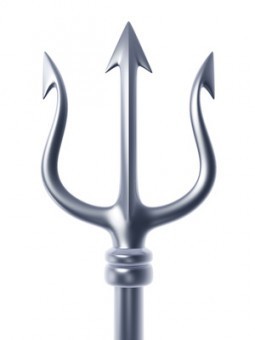 From time to time one of the teachings from the Buddhist tradition will niggle at me for one reason or another. Often it’s because my mind, on some level, is dissatisfied with the traditional interpretation.
From time to time one of the teachings from the Buddhist tradition will niggle at me for one reason or another. Often it’s because my mind, on some level, is dissatisfied with the traditional interpretation.
Even some of the most common teachings of Buddhism, like the four foundations of mindfulness or the twelve links of dependent origination have sometimes struck me as being a bit off, and I’ve ended up reinterpreting them in a way that makes more sense to me.
This recently happened with a teaching on “Three forms of suffering (dukkha)” The traditional interpretations struck me as being a bit random, and I could feel that niggle deep in the belly.
Here’s one interpretation of this teaching (edited for length):
Suffering or Pain (dukkha-dukkhat?). Ordinary suffering, as defined by the English word, is one form of dukkha. This includes physical, emotional and mental pain.
Impermanence or Change (vipari??ma-dukkhat?). Anything that is not permanent, that is subject to change, is dukkha. Thus, happiness is dukkha, because it is not permanent.
Conditioned States (sankh?ra-dukkhat?). To be conditioned is to be dependent on or affected by something else. According to the teaching of dependent origination, all phenomena are conditioned. Everything affects everything else. This is the most difficult part of the teachings on dukkha to understand, but it is critical to understanding Buddhism.
I wasn’t sure at first what was bothering me about this teaching, but eventually I realized that it was repetitive. The third category of suffering encompasses the other two. Impermanence or change (this isn’t change as such but change in the sense of “reversal of fortune”) is just an example of “conditioned states.” So is ordinary suffering.
I dislike this untidiness.
The author I’ve quoted above has also done something that’s common when there’s some uncertainty about the meaning of a Buddhist formula; she’s changed the order. In the original teaching the order is dukkha-dukkhat? (oridinary pain), sankh?ra-dukkhat? (“conditioned states”), and then vipari??ma-dukkhat? (the pain of reversal of fortune). The about.com author has flipped the last two terms, presumably since “conditioned states” is the most general term.
As it happened, this teaching of three forms of suffering and another teaching on dukkha kind of collided one day in my mind. The Buddha talked about two “arrows” of suffering: our initial pain and the pain we give rise to in response to that by resisting, whining, and wishing things were otherwise.
As the Buddha put it:
When touched with a feeling of pain, the uninstructed run-of-the-mill person sorrows, grieves, and laments, beats his breast, becomes distraught. So he feels two pains, physical and mental.
The first of these forms of pain is unavoidable. The second is not. So as they say, “pain is inevitable, suffering is optional.”
But the same passage talks about how clinging to pleasure can be another response to the first arrow, and how this too leads to suffering:
…the uninstructed run-of-the-mill person does not discern any escape from painful feeling aside from sensual pleasure. As he is delighting in sensual pleasure, any passion-obsession with regard to that feeling of pleasure obsesses him. He does not discern, as it actually is present, the origination, passing away, allure, drawback, or escape from that feeling…
So it seems to me that we have here three forms of suffering.
We have initial pain, the first arrow, which is dukkha-dukkhat?. This can be physical or mental. In the teaching of the two arrows, the first pain is physical, of course, but much of our pain is mental. For example when we have “hurt feelings” we feel physical pain, but it’s mediated by the mind. In other words we need to have interpreted some experience as being harmful to us before we can feel this hurt.
Then we have constructed pain — the second arrow. This would be sankh?ra-dukkhat?. Sankh?ra can certainly mean “conditioned” but the most basic meaning of sankh?ra is “that which has been put together.” Hence it can mean “fabricated” or “constructed.” So this is the suffering that we construct through our reactions to physical or mental pain. As the Buddha puts it, “When touched with a feeling of pain, the uninstructed run-of-the-mill person sorrows, grieves, and laments, beats his breast, becomes distraught.”
Then we have a third form of pain, which is delayed. Someone experiences something painful, and then, “Touched by that painful feeling, he delights in sensual pleasure.” So we experience pleasure, but there’s a but … the but being that the pleasure arising from clinging must come to an end. That in itself is painful, but we will almost certainly have to deal with the pain that we were initially running from.
To give an example: I feel lonely right now because my wife and kids are away for the weekend on a family visit. The loneliness is “dukkha-dukkhat?.” It’s mental pain.
But then I find myself moping around, telling myself how sucky my life is, or perhaps telling myself I should be more “detached.” Either way I suffer again. This is fabricated suffering, or sankh?ra-dukkhat?.
Alternatively, I might try to suppress my loneliness by eating too much potato salad (confession: this is exactly what I did!). And while I’m spooning the potato salad into my mouth, I experience pleasure. (It’s really delicious — flavored with shallots.) But the potato salad comes to an end, and I’m still feeling lonely. That’s the suffering that comes when our avoidance mechanisms reach the end of their course: vipari??ma-dukkhat?.
These teachings in the parable of the two arrows and the three forms of suffering match up perfectly. The terms are in the same order in both teaching. The redundancy of having the pain of “conditioned states” as well as two specific kind of painful conditioned states is removed. And we are able to take sankh?ra to have its very basic sense of “constructed” rather than taking it to refer to the entirety of the phenomenal universe. This makes the whole teaching more practical and down-to-earth.
I think this interpretation makes more sense than those commonly given, and in fact I suspect that the teaching of the two arrows and the teaching of the three forms of suffering were originally related. Perhaps the parable of the two arrows was given as a way of illustrating the teaching of three forms of suffering, or perhaps the three forms of suffering were a distillation and explication of the essence of the parable. But to my mind they are the same teaching, expressed in a different fashion.
It’s a minor realignment of the teachings rather than any kind of deep insight, but it’s good to get rid of these niggles.
July 18, 2012
What should the Dalai Lama do about Tibetan self-immolations?
 On CNN, we see two dramatically different views on the Dalai Lama’s position on the wave of self-immolations by Tibetans protesting the Chinese occupation of their country and the persecution of their religion and culture.
On CNN, we see two dramatically different views on the Dalai Lama’s position on the wave of self-immolations by Tibetans protesting the Chinese occupation of their country and the persecution of their religion and culture.
Stephen Prothero, a Boston University religion scholar, author of “The American Bible: How Our Words Unite, Divide, and Define a Nation,” and regular CNN Belief Blog contributor, calls on the Dalai Lama to condemn the protesters.
Tenzin Dorjee, executive director of Students for a Free Tibet, responds, saying that Prothero’s post is a “crass display of moral blindsight” that “blames the victim.”
Dorjee praises the courage of the self-immolators and compares them to past non-violent protestors:
How can the Dalai Lama condemn the self-immolators when their motivation was evidently selfless and their tactic nonviolent? Would we ask Gandhi to condemn activists in the Indian freedom struggle who were killed while lying on the road to block British police trucks? Or the hunger strikers who were starving themselves to death in order to protest the injustices of British rule in India?
He also rightly calls into question some of the odd rhetoric that Prothero employs.
They sacrifice their own lives not in the name of “God” or “Buddha,” as Mr. Prothero so dismissively suggests, but in an altruistic intention of alerting the world to their people’s suffering.
and
From all of Mr. Prothero’s accusations, the most offensive is his comparison of self-immolations to sati – a social system in ancient India where widows were pressured to throw themselves into the funeral pyre of their deceased husbands. Self-immolation – a political act of reason – is the polar opposite of sati – a blind act of superstition.
I’m broadly with Dorjee, and think that as well as distorting what’s going on in Tibet and China, Prothero overlooks the complexities of the Dalai Lama criticizing those who protest against China. There are two prominent problems that spring to mind. First, if the Dalai Lama says “stop the protests,” the Chinese are able to say he’s responsible for them. Second, the Chinese can then say to Tibetans that their own leader has turned against them.
The Dalai Lama walks, as he has acknowledged, a fine line. He can’t approve of violent acts, even if they are violent only to the perpetrator but he also can’t walk into the trap of outright condemning the protests. He is also sensitive to the feelings of the protestors’ families:
If I say something negative, then the family members of those people feel very sad. They sacrificed their … life. It is not easy. So I do not want to create some kind of impression that this is wrong.
He certainly hasn’t encouraged the protestors, but in a BBC interview he in fact questioned their wisdom and the effectiveness of their actions:
In an interview with our correspondent, he said he was not encouraging his followers to sacrifice themselves – as alleged by China.
“The question is how much effect” the self-immolations have, the Dalai Lama said.
“That’s the question. There is courage – very strong courage. But how much effect?
“Courage alone is no substitute. You must utilise your wisdom.”
My own view is that the Dalai Lama displays far more wisdom here than Stephen Prothero, who asks, rather absurdly, “Where are the protests against these Tibetan protesters?”
If we’re going to protest against anything, let it be against the oppression and torture that has driven the Tibetan people to such desperate acts of protest.
July 11, 2012
“Whatever is well said is the word of the Buddha.” Maybe not.
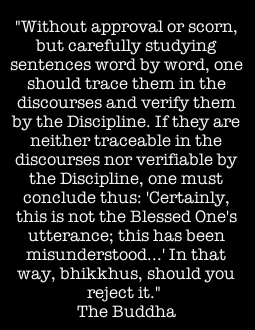 As well as keeping things going at Wildmind, I run a site called “Fake BUddha Quotes,” where I explore some of the sayings misattributed to the Buddha on Facebook, Twitter, quotes sites, and even in books, and attempt to track down their original source. It’s fun to do.
As well as keeping things going at Wildmind, I run a site called “Fake BUddha Quotes,” where I explore some of the sayings misattributed to the Buddha on Facebook, Twitter, quotes sites, and even in books, and attempt to track down their original source. It’s fun to do.
From time to time I receive critical messages from people, claiming that the Buddha was too spiritual to bother about things like being misquoted, or having words put in his mouth. How they know this, I don’t know. Perhaps they have some kind of mystical communion with deceased enlightened beings.
Not having such powers, I have to read the Buddhist scriptures for clues to his attitude. There I find the Buddha, at times, facing people who say “I heard you said such-and-such,” and when that information is incorrect I see him putting them straight, in no uncertain terms. But there’s also a passage in the Digha Nikaya where the Buddha explicitly talks about being misquoted. (Thanks to Arjuna Ranatunga for reminding me of this sutta).
There the Buddha runs through various scenarios where one might hear that the Buddha is reported to have said something or other. What’s our response meant to be?
“Without approval and without scorn, but carefully studying the sentences word by word, one should trace them in the Discourses and verify them by the Discipline. If they are neither traceable in the Discourses nor verifiable by the Discipline, one must conclude thus: ‘Certainly, this is not the Blessed One’s utterance; this has been misunderstood by that bhikkhu — or by that community, or by those elders, or by that elder.’ In that way, bhikkhus, you should reject it.” (Emphasis added.)
That’s what the Fake Buddha Quotes blog is about, although generally I try to find where non-Buddhist quotes have originated and I also post genuine Buddha quotes — or at least things that the Buddha’s canonically said to have said. Being human, I sometimes fall into scorn. I’m working on it, though.
But there you have it above. We’re supposed to think about whether Buddha quotes are genuine. And we’re supposed to “reject” them if they’re not. (I presume that means reject them as genuine, rather than reject their message. Sometimes Fake Buddha Quotes contain inspiring and true messages — it just so happens that the Buddha didn’t say them.)
But there’s another sutta that Arjuna reminded me of, which comes not from the Buddha but from his disciple, Uttara. That sutta contains this oft-quoted saying:
“…whatever is well said is all a saying of the Blessed One, the Worthy One, the Rightly Self-awakened One.”
This would seem to suggest that if the Buddha’s quoted as having said something, then as long as the quote is “well-said” we should accept it as his word. This is a rather odd idea, on the face of it. It’s hard to imagine someone as ethical as the Buddha being prepared to take the credit for others’ bon mots. It also contradicts what we’ve just read. Or it seems to.
Take a look at the context of the sutta, though. Uttara is in a conversation with Sakka, the king of the devas (or gods). As an aside, what does this mean? I tend to assume that such conversations are the recordings of inner dialog. In this case Uttara would have been musing on the nature of authenticity. He’s just given a teaching, and a note (perhaps of doubt) creeps into his mind: “Whose teaching is this, mine or the Buddha’s?” And an answer comes to him: It’s basically the Buddha’s teaching; I just go to the grain pile and carry away basketfuls of Dhamma as I need them. I’d suggest reading the following passage in that light.
“But is this Ven. Uttara’s own extemporaneous invention, or is it the saying of the Blessed One, the Worthy One, the Rightly Self-awakened One?”
“Very well, then, deva-king, I will give you an analogy, for there are cases where it’s through an analogy that observant people can understand the meaning of what is being said. Suppose that not far from a village or town there was a great pile of grain, from which a great crowd of people were carrying away grain on their bodies, on their heads, in their laps, or in their cupped hands. If someone were to approach that great crowd of people and ask them, ‘From where are you carrying away grain?’ answering in what way would that great crowd of people answer so as to be answering rightly?”
“Venerable sir, they would answer, ‘We are carrying it from that great pile of grain,’ so as to be answering rightly.”
“In the same way, deva-king, whatever is well said is all a saying of the Blessed One, the Worthy One, the Rightly Self-awakened One. Adopting it again & again from there do we & others speak.”
Or maybe you believe in gods.
But it’s obvious from the context that what is “well said” refers to that which is taken from the grain pile of the Buddha’s teaching. It seems likely that Uttara was actually saying “whatever I have said that is well said is the word of the Buddha.” This is not unlike a common line that is found in book acknowledgements, along the lines, “Whatever is of value here comes from my teachers; the errors are all my own.” Uttara was not saying that if Voltaire or Douglas Adams or Virginia Wolfe happens to say something neat it can be co-opted as Buddha-vacana — the utterance of the Buddha. So ultimately Uttara’s utterance doesn’t contradict the Buddha’s teaching that we should scrutinize supposed Buddha quotes and reject those that aren’t genuine.
July 10, 2012
Lesbian couple to take vows in Taiwan’s first public Buddhist same-sex union
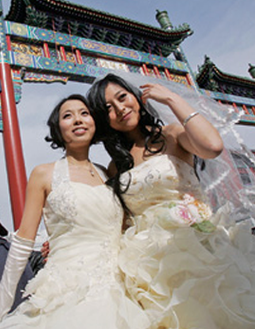 The decision by a Buddhist master to host the event will help push awareness about sexual inequalities further into the public realm, the bride said.
The decision by a Buddhist master to host the event will help push awareness about sexual inequalities further into the public realm, the bride said.
Two devout Buddhist women are to hold the nation’s first gay Buddhist wedding next month as part of an effort to push for the legalization of same-sex marriages in Taiwan.
“We are not only doing it for ourselves, but also for other gays and lesbians,” Fish Huang said in a telephone interview.
The 30-year-old social worker at a non-governmental organization said that marriage never crossed her mind until she saw a movie last year.
The film portrayed two lesbians whose ill-fated relationship concluded after one died and the other was left heartbroken over the denial of spousal benefits.
“It’s so sad,” Huang said, who plans to wed her partner of seven years on Aug. 11 at a Buddhist altar in Taoyuan County.
Both brides are planning to wear white wedding gowns and listen to lectures given by Buddhist masters about marriage, accompanied by a series of chantings and blessings from monks and nuns.
Although homosexual marriages are not legally recognized in Taiwan, Huang insisted on tying the knot because she wants to make her relationship complete and raise awareness about the difficulties faced by sexual minorities.
Alternative sexual orientation and marriage have yet to be widely accepted by the general public, despite years of effort by activists to secure equality in Taiwan.
The first public gay marriage in Taiwan took place in 1996 between a local writer and his foreign partner. The event drew widespread media attention and inspired many gays to follow their footsteps.
Huang’s wedding, however, will be the first with a Buddhist theme.
While planning for her wedding, Huang found out, to her surprise, that some of her Buddhist friends were hesitant about attending the ceremony.
“They are not sure if it would break their vows and were very anxious,” Huang said.
She messaged a Buddhist master on Facebook, asking her if she could find grounds in Buddhism for condemning the practice of homosexuality.
To Huang’s surprise, the master quickly replied that Buddhism shows no bias toward homosexuality. In a demonstration of support, the master said she was willing to host the ceremony for the couple.
“It is meaningful to us that our wedding can give hope to other homosexuals and help heterosexuals understand how Buddhism views sexuality,” Huang said.
The Buddhist master Shih Chao-hwei (???), who is also a professor at Hsuan Chuang University, said Buddhist teachings do not prohibit homosexual behavior.
Compared with Western religions, Buddhism on the whole is more tolerant toward homosexuality because there is no concrete rule banning the practice in Buddhist scriptures, Shih said.
“It’s difficult enough to maintain a relationship … how could you be so stingy as to begrudge a couple for wanting to get married, regardless of their sexual orientation,” she said in a telephone interview.
However, Shih recognized there is disagreement on the issue both inside and outside Buddhist circles.
Shih noted that Huang and her partner could face criticism.
“The first step is always the hardest,” Shih said.
Via Taipei Times.
June 25, 2012
The most fundamental thing you have in common with any other being
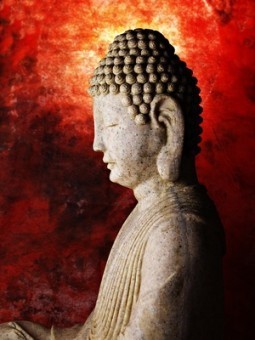 There’s a verse in an ancient Buddhist text that says something to the effect that we all want to be happy, and yet we destroy happiness as if it was an enemy, and we all want to avoid suffering, yet run towards it as if it were a dear friend.
There’s a verse in an ancient Buddhist text that says something to the effect that we all want to be happy, and yet we destroy happiness as if it was an enemy, and we all want to avoid suffering, yet run towards it as if it were a dear friend.
This really resonates with my experience, and recently I’ve been incorporating a reflection based on this into my lovingkindness practice.
I start with myself. I recollect that I do in fact want to be happy and acknowledge how difficult it can be at times to experience joy and wellbeing. And then I ask whether some part of me is prepared to root for my own happiness and wellbeing. The answer is always “yes.”
The phrase “some part of me” is important here, because if you just ask yourself “am I prepared to root for my own happiness,” you might get an ambiguous or negative response. We’re complex beings, and on the surface we may not detect much self-metta (lovingkindness) but one some level there’s always some part of us that’s looking after our interests, protecting us from harm, and keeping us going. Even when you’re depressed, you take care not to walk under a bus while crossing the road.
It’s this self-care, which is intrinsic to our being, that’s the basis of lovingkindness toward others. The Buddha put it like this:
Searching all directions
with one’s awareness,
one finds no one dearer
than oneself.
In the same way, others
are dear, each to themselves.
So one should not hurt others
if one loves oneself.
He also expressed a similar reflection in the Dhammapada:
Life is dear to all. Comparing others with oneself, one should neither strike nor cause to strike.
So I then apply the same reflection to others, starting with the friend: “Do I want to support this person in the struggle they are engaged in to find happiness and to avoid suffering? Is there some part of me that’s willing to root for them?” Again, the answer my heart gives is always “yes.”
Then the neutral person — the person we don’t really know as a person but perhaps as a role, such as a post-office worker, checkout clerk, or colleague. Although I don’t know this person, I’m considering something very fundamental about them. In fact it’s probably the most fundamental thing you could know about any being: they want to be happy, and find it hard to achieve that. They don’t want to suffer, but keep stumbling into suffering. And again, a sense of being prepared to root for this person tends to come quite easily and naturally.
And then the difficult person. Same thing. They are driven to find happiness, but find happiness elusive; impelled to avoid suffering, and yet they keep experiencing suffering. They’re just like me. Is there some part of me that can support them, root for them? And this is where the “some part of me” comes in handy again.
You don’t have to like the person you have conflict with. You don’t have to love them. You don’t have to think they’re a nice person. You don’t have to forget bad things they’ve done for you. It may actually cause you pain to call this person to mind (accept that pain!). But you can acknowledge that they want to be happy and find happiness hard to attain, and want not to suffer but cause themselves a lot of pain. And it’s not hard, recognizing that they’re just like us in this regard, to find that some part of us wants to support them.
I find this the most powerful way to connect with metta as something inherent. Although metta is something that needs to be developed, it’s not conjured from thin air. It needs first to be uncovered. This reflection helps reveal the lovingkindness that’s already within us. At our core we don’t want others to suffer, and want them to be happy, because in our hearts we know that what is true for them is true for us as well.
June 19, 2012
On Eating Animals, by Namit Arora
In a Montana slaughterhouse some years ago, a black Angus cow awaiting execution suddenly went berserk, jumped a five-foot fence, and escaped. She ran though the streets for hours, dodging cops, animal control officers, cars, trucks, and a train. Cornered near the Missouri river, the frightened animal jumped into its icy waters and made it across, where a tranquilizer gun brought her down. Her “daring escape” stole the hearts of the locals, some of whom had even cheered her on. The story got international media coverage. Telephone polls were held, calls demanding her freedom poured into local TV stations. Sensing the public mood, the slaughterhouse manager “granted clemency” to the “brave cow”. Now called Molly, she was sent to a nearby farm to live out her days grazing under open skies—which warmed the cockles of many a heart.
Cattle trying to escape slaughterhouses are not uncommon. Few of their stories end happily though.
Related posts:
Interview with Jonathan Safran Foer, author of Eating Animals.
Can you be a vegan and eat animals?
They Eat Horses, Don’t They?



